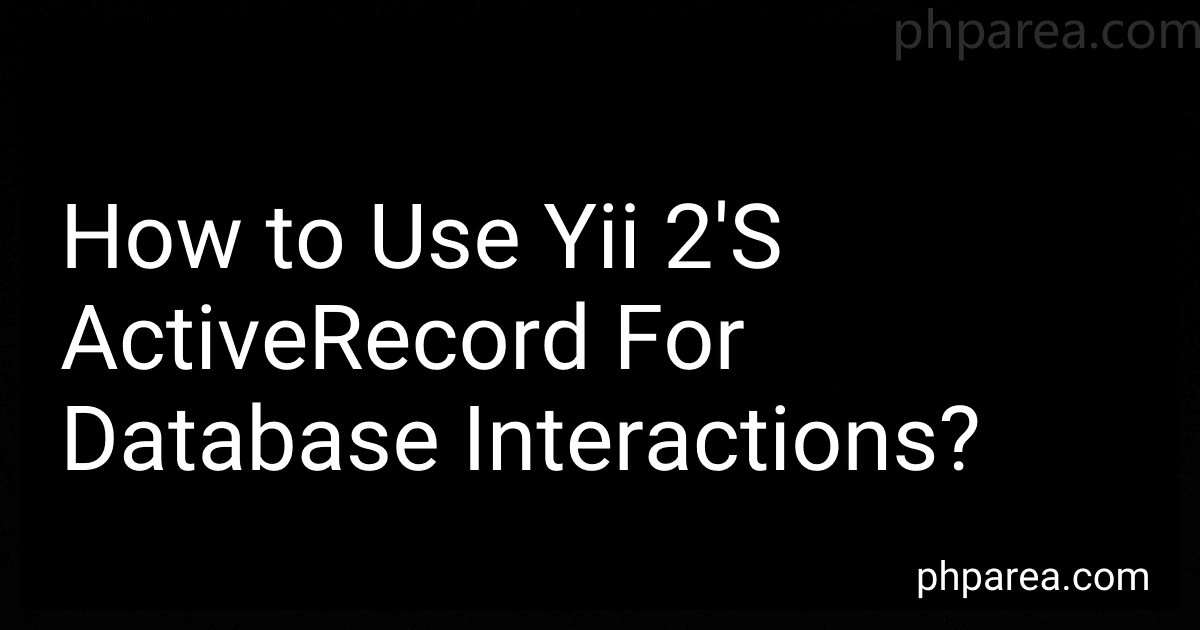Posts (page 112)
-
 13 min readCaching is an essential technique for improving the performance of web applications. In Yii 2, implementing caching is quite straightforward. Here's how you can do it:Enable caching: Yii 2 provides support for various caching methods like file caching, database caching, and memcached. Depending on your application's requirements, you can choose the appropriate caching method. Configuration: Open the configuration file (config/web.php) and locate the components section.
13 min readCaching is an essential technique for improving the performance of web applications. In Yii 2, implementing caching is quite straightforward. Here's how you can do it:Enable caching: Yii 2 provides support for various caching methods like file caching, database caching, and memcached. Depending on your application's requirements, you can choose the appropriate caching method. Configuration: Open the configuration file (config/web.php) and locate the components section.
-
 8 min readYii 2 is a popular PHP framework that includes a powerful RESTful API feature. This feature allows you to build APIs easily and efficiently. Here's an overview of how to use Yii 2's RESTful API features.To start, you need to configure your application to support RESTful API. You can do this by modifying the application's configuration file, which often resides in the config directory. Usually, this file is named main.php or web.php.
8 min readYii 2 is a popular PHP framework that includes a powerful RESTful API feature. This feature allows you to build APIs easily and efficiently. Here's an overview of how to use Yii 2's RESTful API features.To start, you need to configure your application to support RESTful API. You can do this by modifying the application's configuration file, which often resides in the config directory. Usually, this file is named main.php or web.php.
-
 7 min readYii 2's grid view widget is a powerful tool that allows you to display tabular data in a customizable and interactive manner. It offers various features like sorting, filtering, pagination, and column customization to enhance the user experience. Working with Yii 2's grid view widget involves the following steps:To begin, you need to configure the grid view widget in your view file. Use the GridView class and specify the dataProvider property to provide the data for the grid.
7 min readYii 2's grid view widget is a powerful tool that allows you to display tabular data in a customizable and interactive manner. It offers various features like sorting, filtering, pagination, and column customization to enhance the user experience. Working with Yii 2's grid view widget involves the following steps:To begin, you need to configure the grid view widget in your view file. Use the GridView class and specify the dataProvider property to provide the data for the grid.
-
 7 min readIn Yii 2, handling forms and validations is made easy and efficient with the help of built-in features and components. Here is an overview of how you can handle forms and validations in Yii 2:Model Creation: Begin by creating a model that represents the data you want to collect in the form. Yii 2 provides an ActiveRecord model that makes it easy to interact with the database.
7 min readIn Yii 2, handling forms and validations is made easy and efficient with the help of built-in features and components. Here is an overview of how you can handle forms and validations in Yii 2:Model Creation: Begin by creating a model that represents the data you want to collect in the form. Yii 2 provides an ActiveRecord model that makes it easy to interact with the database.
-
 9 min readYii 2's RBAC (Role-Based Access Control) system provides an efficient way to manage access control in your application based on user roles. It allows you to define roles, permissions, and assign these to users.To start using Yii 2's RBAC system, you need to perform the following steps:Create a database table to store RBAC data. Yii 2 provides a migration command to create the necessary table, or you can create it manually.
9 min readYii 2's RBAC (Role-Based Access Control) system provides an efficient way to manage access control in your application based on user roles. It allows you to define roles, permissions, and assign these to users.To start using Yii 2's RBAC system, you need to perform the following steps:Create a database table to store RBAC data. Yii 2 provides a migration command to create the necessary table, or you can create it manually.
-
 8 min readYii 2 is a powerful PHP framework that allows developers to easily create web applications. One of the key features of Yii 2 is the ability to create and apply console commands. Console commands are scripts that can be executed via the command line, allowing developers to perform various tasks outside of the web application context.To create a console command in Yii 2, you need to follow these steps:Create a new class that extends the 'yii\console\Controller' base class.
8 min readYii 2 is a powerful PHP framework that allows developers to easily create web applications. One of the key features of Yii 2 is the ability to create and apply console commands. Console commands are scripts that can be executed via the command line, allowing developers to perform various tasks outside of the web application context.To create a console command in Yii 2, you need to follow these steps:Create a new class that extends the 'yii\console\Controller' base class.
-
 13 min readTo implement user authentication in Yii 2, you can follow these steps:Firstly, ensure that you have a User model that represents your user table in the database and a LoginForm model that represents the login form. In the User model, implement the yii\web\IdentityInterface interface. This requires implementing methods such as findIdentity(), findIdentityByAccessToken(), getId(), getAuthKey(), and validateAuthKey(). These methods handle the retrieval and validation of user information.
13 min readTo implement user authentication in Yii 2, you can follow these steps:Firstly, ensure that you have a User model that represents your user table in the database and a LoginForm model that represents the login form. In the User model, implement the yii\web\IdentityInterface interface. This requires implementing methods such as findIdentity(), findIdentityByAccessToken(), getId(), getAuthKey(), and validateAuthKey(). These methods handle the retrieval and validation of user information.
-
 8 min readYii 2's ActiveRecord is a powerful feature that facilitates easy database interactions in your application. Here's an overview of how you can use Yii 2's ActiveRecord for database operations:Define a Model: ActiveRecord uses models to represent database tables. Create a model class that extends the yii\db\ActiveRecord base class. Specify the table name, primary key, and attributes in the model class. Configure Database Connection: Yii 2 provides a configuration file (config/db.
8 min readYii 2's ActiveRecord is a powerful feature that facilitates easy database interactions in your application. Here's an overview of how you can use Yii 2's ActiveRecord for database operations:Define a Model: ActiveRecord uses models to represent database tables. Create a model class that extends the yii\db\ActiveRecord base class. Specify the table name, primary key, and attributes in the model class. Configure Database Connection: Yii 2 provides a configuration file (config/db.
-
 6 min readYii 2 is a PHP framework that provides a powerful tool called migrations for managing database-related changes. Migrations allow you to create and apply changes to your database schema in a version-controlled manner. Here's a brief explanation on how to create and apply Yii 2 migrations without using list items:Create a new migration: To create a new migration, you need to run the yii migrate/create command in your terminal or command prompt followed by the name of the migration.
6 min readYii 2 is a PHP framework that provides a powerful tool called migrations for managing database-related changes. Migrations allow you to create and apply changes to your database schema in a version-controlled manner. Here's a brief explanation on how to create and apply Yii 2 migrations without using list items:Create a new migration: To create a new migration, you need to run the yii migrate/create command in your terminal or command prompt followed by the name of the migration.
-
 9 min readTo generate CRUD operations with Gii in Yii 2, you can follow the steps:Ensure that you have properly installed Yii 2 and have Gii extension enabled in your project.Open the Gii tool in your web browser by accessing the URL path "your_project/web/index.php?r=gii". Replace "your_project" with the actual path to your Yii 2 project.In the Gii homepage, click on the "Model Generator" link.
9 min readTo generate CRUD operations with Gii in Yii 2, you can follow the steps:Ensure that you have properly installed Yii 2 and have Gii extension enabled in your project.Open the Gii tool in your web browser by accessing the URL path "your_project/web/index.php?r=gii". Replace "your_project" with the actual path to your Yii 2 project.In the Gii homepage, click on the "Model Generator" link.
-
 9 min readTo set up and configure a database connection in Yii 2, follow these steps:Open the config/db.php file in your Yii 2 application's root directory. Inside this file, define a new array with the database connection configuration. The basic structure of the array should include the following key-value pairs: dsn: The Data Source Name (DSN) string that specifies the database driver and server details. username: The username to be used for connecting to the database.
9 min readTo set up and configure a database connection in Yii 2, follow these steps:Open the config/db.php file in your Yii 2 application's root directory. Inside this file, define a new array with the database connection configuration. The basic structure of the array should include the following key-value pairs: dsn: The Data Source Name (DSN) string that specifies the database driver and server details. username: The username to be used for connecting to the database.
-
 11 min readIn Yii 2, migrations are used to manage the database schema in an organized and version-controlled manner. Migrations allow you to create, modify, and delete database tables, columns, indexes, and foreign keys using PHP code.To create a new migration, you need to execute the yii migrate/create command in the terminal, followed by a migration name. This command will generate a new migration file in the 'migrations' directory of your Yii 2 application.
11 min readIn Yii 2, migrations are used to manage the database schema in an organized and version-controlled manner. Migrations allow you to create, modify, and delete database tables, columns, indexes, and foreign keys using PHP code.To create a new migration, you need to execute the yii migrate/create command in the terminal, followed by a migration name. This command will generate a new migration file in the 'migrations' directory of your Yii 2 application.